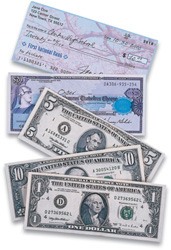Section 3 Banking Today
Preview
Objectives
After studying this section you will be able to:
- Explain how the money supply in the United States is measured.
- Explain the functions of financial institutions.
- Identify different types of financial institutions.
- Understand the changes brought about by electronic banking.
Section Focus
Banking has changed greatly in recent decades. Today, many people are likely to use credit or debit cards instead of cash or checks. Banks provide a large array of services, and electronic banking is revolutionizing the way people conduct banking transactions.
Key Terms
- money supply
- liquidity
- demand deposit
- money market mutual fund
- fractional reserve banking
- default
- mortgage
- credit card
- interest
- principal
- debit card
- creditor
Do you have a checking account, credit card, or ATM card? If you don't, you most likely will in the near future. As this question suggests, people in the United States today use more than just paper currency and coins to pay for purchases.
Measuring the Money Supply
You are familiar with paying for the items you need with currency—the bills and coins in your pocket. Money consists of currency. It also consists of traveler's checks, checking account deposits, and a variety of other components. All of these components make up the United States money supply—all the money available in the United States economy. To more easily keep track of these different kinds of money, economists divide the money supply into several categories. The main categories are called M1 and M2.
M1
M1 represents money that people can gain access to easily and immediately to pay for goods and services. In other words, M1 consists of assets that have liquidity, or the ability to be used as, or directly converted into, cash.
As you can see from Figure 10.5, about 48 percent of M1 is made up of currency held by the public, that is, all currency held outside of bank vaults. Another large part of M1 is deposits in checking accounts. Funds in checking accounts are also called demand deposits because checks can be paid “on demand,” that is, at any time. Until the 1980s, checking accounts did not pay interest, and a new category, called other checkable deposits, was introduced to describe checking accounts that did pay interest. Today this distinction is not as meaningful as it once was since many checking accounts pay interest if your balance is sufficiently high.
Traveler's checks make up a very small component of M1. Unlike personal checks, traveler's checks can be easily turned into cash.
M2
M2 consists of all the assets in M1 plus several additional assets. These additional M2 funds cannot be used as cash directly, but can be converted to cash fairly easily. M2 assets are also called near money.
For example, deposits in savings accounts are included in M2. They are not included in M1 because they cannot be used directly in financial exchanges. You cannot hand a sales clerk your savings account passbook to pay for a new backpack. You can, however, withdraw money from your savings account and then use that money to buy a backpack.

Assets that have liquidity include currency, funds in checking accounts, and traveler's checks.




